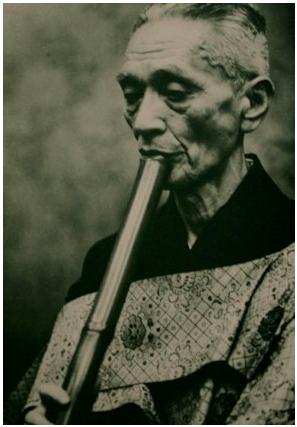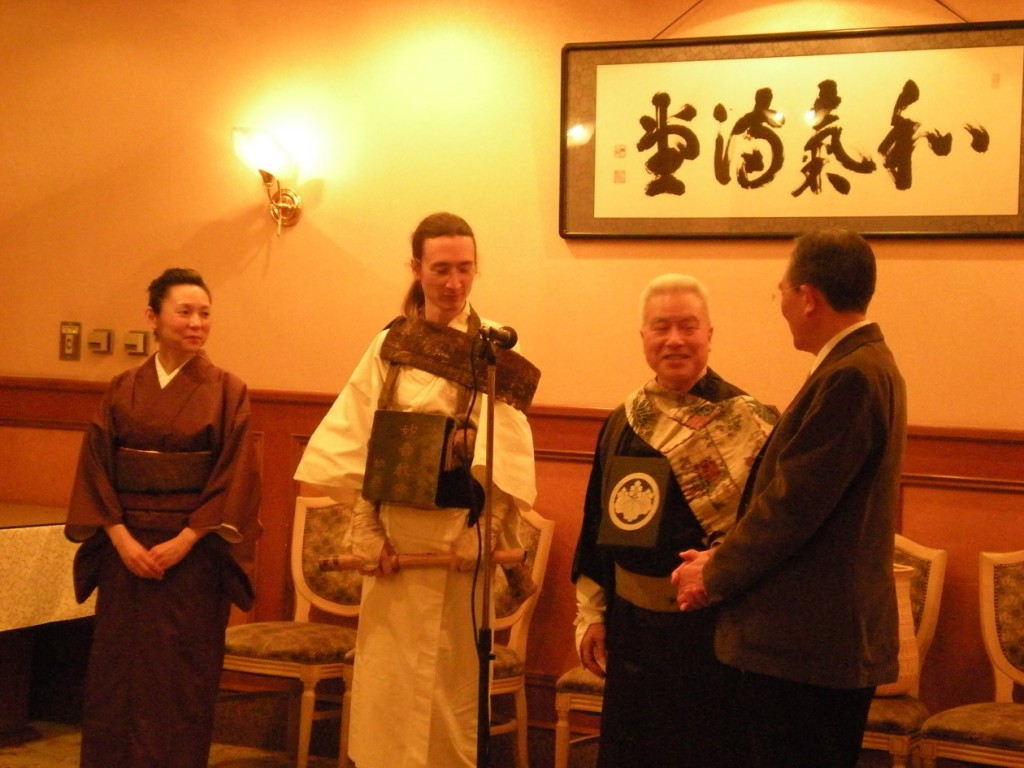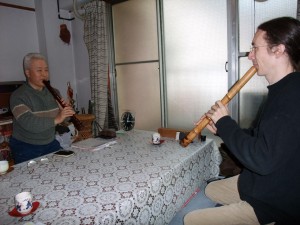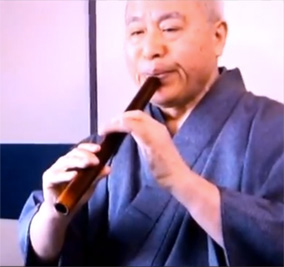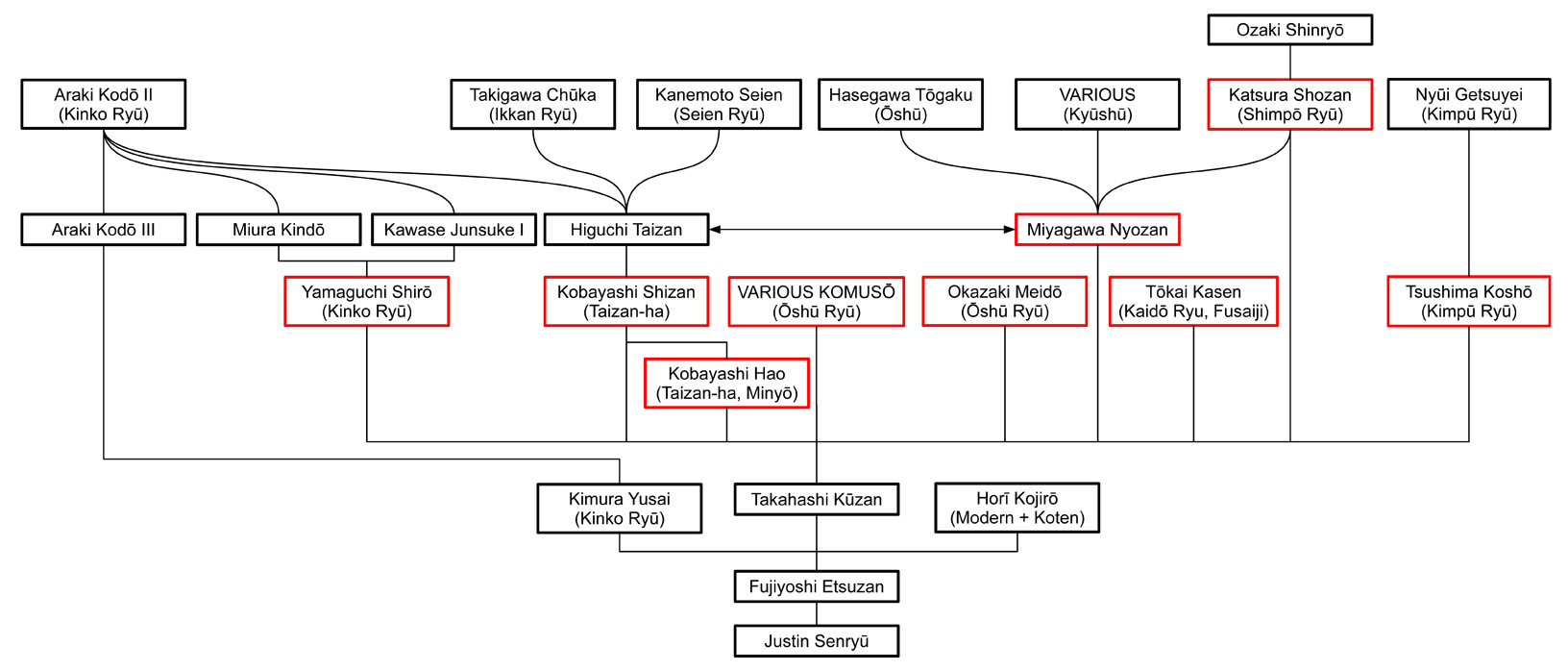Takahashi Kuzan (1900~1986) was born in Hokkaido and grew up in Yamagata in the Northern part of Japan. He studied shakuhachi from many of the old komuso there in the local Oshu style, as well as studying various martial arts. He traveled around Japan, studying with the masters of the various lineages of shakuhachi honkyoku, as well as studying the music of the ancient hitoyogiri, Satsuma biwa and hichiriki.
Kuzan settled in Tokyo where he opened a dojo to teach the traditional three pillars of komuso art, “teki zen ken” – shakuhachi, zazen and martial arts – as well as teaching calligraphy. He became widely renowned as a master of shakuhachi and preserver of the old traditions, and is said to have learned over 260 pieces. Some of the pieces were learned from the last remaining players and were preserved in no other lineages, in particular the honkyoku repertoire of Fusaiji in Ise (for example “Tamuke”), and repertoire of Shinobu-ryu.
Among his teachers were the great masters Miyagawa Nyozan, Okazaki Meido and Katsuura Shozan.
Miyagawa Nyozan, originally a Kyushu shakuhachi player, became a top student and colleague of Higuchi Taizan, studying Taizan’s music as well as sharing his own music with Taizan. He is known throughout the honkyoku world as the creator of the outstanding masterpiece ‘Ajikan’.
Okazaki Meido was a master of Oshu style and regarded by many of his contemporaries as the best source for the masterpiece ‘Fudaiken Reibo’.
Katsuura Shozan was the head of Shimpo Ryu, the original honkyoku style of Myoan Temple in Kyoto and was the source of all Kyoto honkyoku.
Fujiyoshi Etsuzan
Justin had the good fortune to meet Fujiyoshi Etsuzan by chance in Tokyo – a student of Takahashi Kuzan and renowned throughout Japan as the inheritor of his tradition. After three years of waiting Justin was finally accepted as a student. His extensive studies of 44 pieces including pieces from Oshu Kei, Myoan Shimpo Ryu, Taizan Ryu and others, culminated in the precious transmission of Miyagawa Nyozan’s honkyoku Ajikan, a most difficult piece, which in this tradition and particular line of transmission is held in highest regard.
Fujiyoshi Etsuzan started shakuhachi while at University, studying briefly with Kinko Ryu Araki-ha teacher Kimura Yusai and both honkyoku and modern shakuhachi with Horii Kojiro. After meeting Takahashi Kuzan he was accepted as his student, and was so impressed that he remained with him for the next 26 years, until Kuzan’s passing. As well as studying his extensive shakuhachi repertoire, Kuzan also taught Etsuzan to play hitoyogiri, an ancient relative of Fuke shakuhachi, which Etsuzan also taught to Justin. Etsuzan is also a skilled player of shinobue (Japanese vertical flute used in traditional festival music); Korean tanso and piri; and Chinese xiao, dizi and bao.
Lineage chart
The chart below shows the transmission of music within this lineage. Lineage charts in Japanese culture often show only the main teacher of each individual. The main teacher is regarded as the most important, and indeed often students would be expected to refrain from studying under any other teacher. This relationship is known as ‘shitei kankei’. However, although today it is usual for students to have only one teacher, the reality of the history of honkyoku transmission has been far more complex, many players having gained their honkyoku repertoires from a number or teachers; from friends; and at times even from their own students. (See for example Yamaue Getsuzan, Watazumi and Jin Nyodo).
This chart therefore details both the main teachers, such as Miyagawa Nyozan’s main teacher being Higuchi Taizan, and Fujiyoshi Etsuzan’s main teacher being Takahashi Kuzan; and secondary teachers, such as Takahashi Kuzan learning Oshu pieces from Okazaki Meido, and Fujiyoshi Etsuzan learning several honkyoku, in particular Jimbo Sanya, from Horii Kojiro. In this way we can see how the regional styles gathered together to form the precious repertoire of this lineage.
For added clarity, the teachers from whom Takahashi Kuzan studied have been coloured in red.

